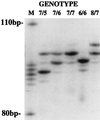Racial variability in the UDP-glucuronosyltransferase 1 (UGT1A1) promoter: a balanced polymorphism for regulation of bilirubin metabolism?
- PMID: 9653159
- PMCID: PMC20948
- DOI: 10.1073/pnas.95.14.8170
Racial variability in the UDP-glucuronosyltransferase 1 (UGT1A1) promoter: a balanced polymorphism for regulation of bilirubin metabolism?
Abstract
A polymorphism in the promoter of the UDP-glucuronosyltransferase 1 (UGT1A1) gene has been shown to cause Gilbert syndrome, a benign form of unconjugated bilirubinemia. Promoters containing seven thymine adenine (ta) repeats have been found to be less active than the wild-type six repeats, and the serum bilirubin levels of persons homozygous or even heterozygous for seven repeats have been found to be higher than those with the wild-type six repeats. We have now examined the genotypes in persons of Asian, African, and Caucasian ancestry. Although within the Caucasian ethnic group there is a strong correlation between promoter repeat number and bilirubin level, between ethnic groups we found that this relationship to be inverse. Among people of African ancestry there are, in addition to those with six and seven repeats, also persons who have five or eight repeats. Using a reporter gene we show that there is an inverse relationship between the number of ta repeats and the activity of the promoter through the range of 5-8 ta repeats. An incidental finding was a polymorphism at nucleotide -106, tightly linked to the (ta)5 haplotype. Serum bilirubin levels are influenced by many factors, both genetic and environmental. We suggest that the unstable UGT1A1 polymorphism may serve to "fine-tune" the plasma bilirubin level within population groups, maintaining it at a high enough level to provide protection against oxidative damage, but at a level that is sufficiently low to prevent kernicterus in infants.
Figures


References
-
- Mansouri A, Nandy I. J Invest Med. 1998;46:82–86. - PubMed
-
- Bosma P J, Chowdhury N R, Goldhoorn B G, Hofker M H, Oude E R, Jansen P L, Chowdhury J R. Hepatology. 1992;15:941–947. - PubMed
-
- Bosma P J, Chowdhury J R, Bakker C, Gantla S, de Boer A, Oostra B A, Lindhout D, Tytgat G N, Jansen P L, Oude Elferink R P. N Engl J Med. 1995;333:1171–1175. - PubMed
-
- Aono S, Adachi Y, Uyama E, Yamada Y, Keino H, Nanno T, Koiwai O, Sato H. Lancet. 1995;345:958–959. - PubMed
Publication types
MeSH terms
Substances
Grants and funding
LinkOut - more resources
Full Text Sources
Other Literature Sources

